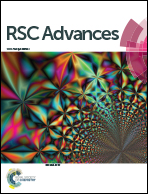Microbial transformation of methyl cyperenoate by Cunninghamella elegans AS 3.2028 and the antithrombotic activities of its metabolites†
Abstract
Microbial transformation is a remarkable tool for the structural modification of bioactive natural compounds converting them into more valuable biologically active derivatives. In order to obtain the bioactive metabolites of methyl cyperenoate, it was biotransformed using Cunninghamella elegans AS 3.2028 to afford eight new derivatives (1–8) including six new hydroxylated metabolites (2–6, 8), one new oxidation metabolite (7), along with one unusual new dehydration metabolite (1). Metabolite 1 and metabolite 7 with unsaturated ring C were found in patchoulane sesquiterpene for the first time. In addition, the biotransformation time-course of methyl cyperenoate by Cunninghamella elegans AS 3.2028 was described and the possible transformation pathway was also proposed on the basis of structural analyses and biotransformation time-courses. It was noteworthy that the major biotransformation reactions only occurred in ring C of methyl cyperenoate. All the biotransformation metabolites were tested in vitro for antithrombotic activity by measuring the platelet count, together with the partial thromboplastin time (APTT), the thrombin time (TT) and the prothrombin time (PT). The biotransformation derivatives 1–3 exhibited potent antithrombotic activity in vitro. Furthermore, the active compounds 1–3 were tested for their in vivo antithrombotic activity using a transgenic zebrafish model and compound 1 exhibited good antithrombotic activity in this model. Interestingly, transformation derivative 1 displayed potent antithrombotic activity both in vivo and in vitro compared with its precursor (the original compound), suggesting that it could be a promising agent for further preclinical evaluation for preventing abnormal blood clotting.


 Please wait while we load your content...
Please wait while we load your content...